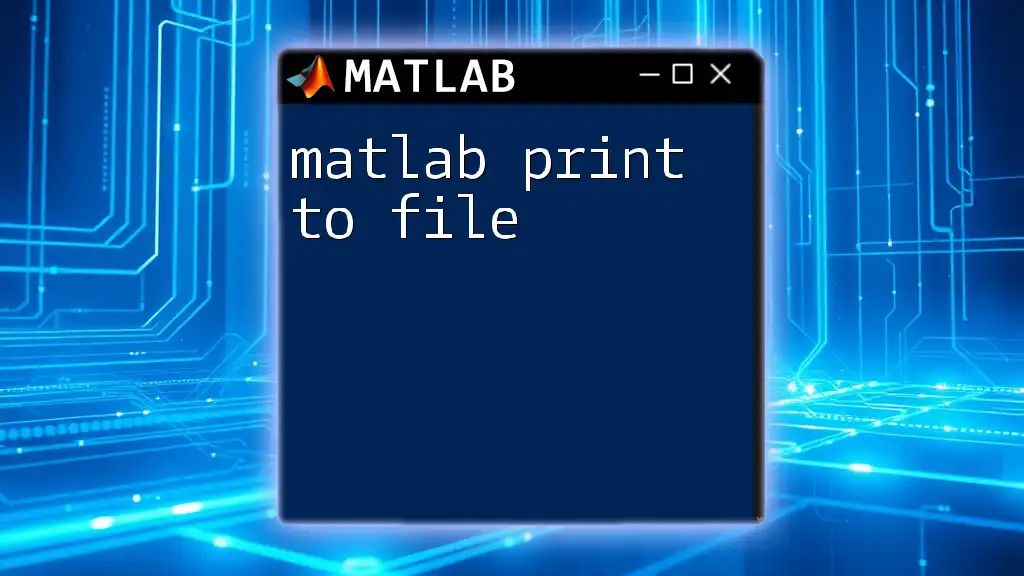In MATLAB, you can print figures or data to a file using the `print` function, specifying the desired output format and filename. Here's a basic example:
print('myFigure','-dpng') % This command saves the current figure as a PNG file named "myFigure.png".
Understanding the Print Function in MATLAB
What is the Print Function?
The `print` function is a powerful tool in MATLAB that allows users to generate high-quality outputs of figures created during their analysis or modeling tasks. It serves multiple purposes, such as exporting figures for reports, creating images for presentations, and capturing graphical representations of data.
Syntax of the Print Function
The general syntax for the `print` function is outlined as follows:
print(filename, fmt, options)
Here, the filename specifies the name of the output file, fmt refers to the format in which the figure should be saved, and options can include various settings and parameters to customize the output.
A deep understanding of the syntax is crucial for efficiently utilizing MATLAB print to file capabilities, enabling you to produce the desired output with minimal effort.

Supported File Formats
Commonly Used Formats
When using the `print` function, several file formats are supported, including:
- JPEG: Suitable for photos and bitmap images, offering a good compression ratio.
- PNG: Ideal for graphics with transparency, which maintains image quality without loss.
- PDF: Perfect for vector graphics, ensuring high-quality printouts and scalability.
- EPS: A vector format commonly used in publishing for its ability to provide high-quality output.
Understanding when to use each format can help ensure that your saved graphics meet the requirements of your audience or application, whether for electronic presentations or print publications.
How to Specify the Format
You can specify the format in the `print` function easily. For instance, by using the `-dpng` option, you indicate that the output file should be saved as a PNG:
print('myfigure', '-dpng');
This simple modification allows for flexibility in output quality and size.

Saving Figures to File
Basic Example of Printing a Figure
To save a basic figure, you can follow these steps. Create a plot and use the `print` function to generate a file. For example:
x = 0:0.1:10;
y = sin(x);
plot(x, y);
print('myfigure', '-dpng');
In this script:
- `x` and `y` create a simple sine wave plot.
- The `plot` function displays the generated figure.
- `print('myfigure', '-dpng')` saves the figure in the current directory as 'myfigure.png'.
Setting Resolution and Size
Controlling Image Quality
You can control the resolution of your output figure by specifying the `-r` option followed by the desired resolution in DPI (dots per inch). For example:
print('myfigure', '-dpng', '-r300');
Here, the figure is saved at a resolution of 300 DPI, which is ideal for high-quality print publications.
Specifying Figure Dimensions
Another aspect of customizing your output involves setting the dimensions of your figure. This can be done using the `PaperPosition` property. For instance, to create a 5x5 inch figure, you would include the following code:
set(gcf, 'PaperPosition', [0 0 5 5]); % Specifies the size in inches
print('myfigure', '-dpng');
By adjusting these parameters, you can ensure that your saved figures meet specific layout requirements.

Printing to PDF Files
Why Use PDF Format?
Saving figures as PDFs is particularly beneficial for maintaining vector quality, which ensures that images do not lose clarity when zoomed. This format is often preferred for documents intended for further editing or publishing.
Example of Saving a Figure as a PDF
Here's how you can save a figure in PDF format:
x = 0:0.1:10;
y = cos(x);
plot(x, y);
print('myfigure', '-dpdf');
In this example, a cosine wave is generated and saved as 'myfigure.pdf'. This ensures that the output will retain high quality, regardless of how it's viewed or printed.

Advanced Options for Printing
Customizing Output
MATLAB offers various advanced features for customizing printed outputs. You might consider adjusting color settings (e.g., printing in color versus black-and-white) or font settings to enhance readability in your exported figures.
Using the MATLAB `exportgraphics` Function
An alternative to the `print` function is the `exportgraphics` function, particularly useful for modern graphics outputs. It's generally easier to use and offers more customization options:
exportgraphics(gcf, 'myfigure.pdf', 'Resolution', 300);
This command exports the current figure to a PDF with the specified resolution, providing a user-friendly way to generate high-quality files.

Automating the File Saving Process
Saving Multiple Figures in a Loop
If you need to save multiple figures efficiently, you can leverage loops. Here’s how to automate the process:
for k = 1:5
figure;
plot(rand(1, 10));
print(['Figure' num2str(k)], '-dpng');
end
This loop creates and saves five separate figures, automatically naming them 'Figure1.png', 'Figure2.png', and so on. Automation increases productivity significantly when working with large datasets or multiple visualizations.

Troubleshooting Common Issues
What to Do When Print Fails
Common errors may arise when using the `print` function, such as file permission issues or incorrect file paths. Be sure to check for write permissions in the specified directory or verify that the file naming conventions are followed correctly.
Ensuring Compatibility
To ensure that your output files are compatible with various software (like PowerPoint or Word), always check the capabilities of the application you plan to use for importing the files. Generally, formats like PDF, PNG, and JPEG tend to be widely accepted.

Conclusion
By mastering the `matlab print to file` functionality, you equip yourself with the tools needed to create professional-quality visualizations suitable for numerous purposes, from academic papers to business presentations. Experimenting with resolutions, formats, and automation can take your MATLAB graphics to the next level, enhancing both the presentation and clarity of your work.

















